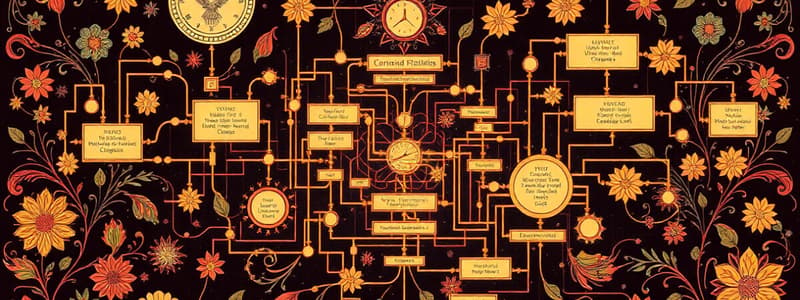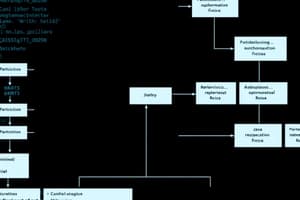Podcast
Questions and Answers
What is the primary purpose of using algorithms in programming?
What is the primary purpose of using algorithms in programming?
- To visualize data
- To create user interfaces
- To store data efficiently
- To provide a sequence of steps to solve a problem (correct)
What does a flowchart represent in programming?
What does a flowchart represent in programming?
- A storage system for data
- A graphical representation of an algorithm (correct)
- A collection of programming rules
- A list of programming languages
Which step is NOT part of the example algorithm for adding two numbers?
Which step is NOT part of the example algorithm for adding two numbers?
- Input A, B
- Stop
- Output A (correct)
- Calculate C=A+B
In the context of programming, what is a significant feature of pseudo code?
In the context of programming, what is a significant feature of pseudo code?
What is the first step in the algorithm for the addition of two numbers?
What is the first step in the algorithm for the addition of two numbers?
Which symbol is used to indicate the start or stop in a flow chart?
Which symbol is used to indicate the start or stop in a flow chart?
What function does a parallelogram serve in a flow chart?
What function does a parallelogram serve in a flow chart?
In a flow chart, which symbol represents decision making?
In a flow chart, which symbol represents decision making?
What is the purpose of flow lines in a flow chart?
What is the purpose of flow lines in a flow chart?
What is a characteristic of a control structure?
What is a characteristic of a control structure?
Which type of control structure is used when a program must decide how many times to execute a certain action?
Which type of control structure is used when a program must decide how many times to execute a certain action?
In the flow chart example for the average of two numbers, what operation is performed after the input of A and B?
In the flow chart example for the average of two numbers, what operation is performed after the input of A and B?
In the greatest of two numbers algorithm, which operation follows the input of A and B?
In the greatest of two numbers algorithm, which operation follows the input of A and B?
What is the first step in the algorithm for displaying the first 5 natural numbers?
What is the first step in the algorithm for displaying the first 5 natural numbers?
What will be the output when a student's grade is 59 based on the pseudo code provided?
What will be the output when a student's grade is 59 based on the pseudo code provided?
Which programming language is specifically designed for business applications?
Which programming language is specifically designed for business applications?
In the flowchart described for a person with fever, what is checked?
In the flowchart described for a person with fever, what is checked?
What is the role of a Database Management System (DBMS)?
What is the role of a Database Management System (DBMS)?
What will happen after the output of 'i' in the algorithm for displaying natural numbers?
What will happen after the output of 'i' in the algorithm for displaying natural numbers?
Which of the following is not a programming language mentioned?
Which of the following is not a programming language mentioned?
What will be printed if A is greater than B in the flowchart?
What will be printed if A is greater than B in the flowchart?
Study Notes
Introduction
- To solve programming problems, use algorithms, flowcharts, and pseudocode.
- This text covers algorithms, flowcharts, control structures, pseudocode, databases, database management systems, and programming languages.
Algorithm
- A sequence of steps performed to solve a problem by a computer.
- Example: Adding two numbers.
- Input two numbers (A and B).
- Calculate C = A + B.
- Output C.
Flowchart
- A symbolic representation of an algorithm.
- Includes symbols to represent steps, such as:
- Oval: Start/Stop.
- Parallelogram: Input/Output.
- Rectangle: Processing.
- Diamond: Decision Making.
- Circle: Connector.
- Flow lines: Control Flow.
Control Structures
- A block of programming that analyzes variables and chooses a direction based on parameters.
- Two types:
- Branching: Makes decisions about what actions to take.
- Looping: Makes decisions about how many times to take a certain action.
Branching
- Example: Finding the greatest of two numbers.
- Input two numbers (A and B).
- If A is greater than B, output A.
- Otherwise, output B.
Looping
- Example: Displaying the first five natural numbers using a "while" loop.
- Set a counter variable "i" to 0.
- While "i" is less than 5:
- Output the value of "i".
- Increment "i" by 1.
Pseudocode
- A high-level representation of an algorithm, written in plain language.
- Example: Checking if a student passes or fails based on their grade.
- If the student's grade is greater than or equal to 60, print "Pass", otherwise, print "Fail".
Database
- A collection of related data.
- Example: A database of student information.
Database Management System (DBMS)
- Software that helps maintain and utilize large collections of data.
Programming Languages
- Formal languages used to communicate instructions to computers.
- Examples: C, C++, Java, COBOL, FORTRAN.
Compiler and Interpreter
- Compiler: A program that translates code written in a high-level language (like C++) into a low-level language (like machine code) that a computer can understand.
- Interpreter: A program that executes code line by line, without needing to compile it first.
Programming Language Use
- COBOL: Common Business Oriented Language, used for business applications.
- FORTRAN: FORmula TRANslation, used for scientific applications
- C, C++, Java, Pascal, Visual BASIC: General purpose languages used in education and for various applications.
Studying That Suits You
Use AI to generate personalized quizzes and flashcards to suit your learning preferences.
Related Documents
Description
Test your knowledge on programming fundamentals including algorithms, flowcharts, control structures, and pseudocode. This quiz will help reinforce your understanding of how to solve problems using various programming concepts. Prepare to apply your skills in database management systems as well.




